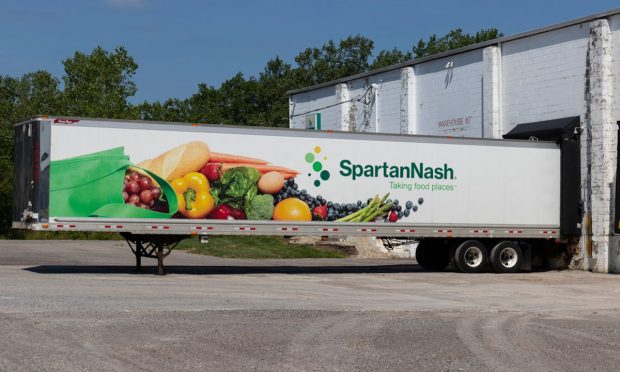SpartanNash Leverages Retail Arm to Optimize Distribution Business

While grocery stores around the world are rapidly getting a digital upgrade alongside the industry’s omnichannel shift, innovation looks very different in the back office. Payments are becoming digitized more slowly, and automated solutions for labor-intensive processes are just beginning to emerge, enabling businesses across the supply chain to make it through the labor shortages plaguing the food industry.
When it comes to the tools and technologies needed to keep the supply chain running smoothly, food distributor and retailer SpartanNash is in the unique position of understanding the needs of both parties — distributor and retailer — which informs the way it interacts with its customers.
“[We] operate nearly 150 grocery stores in a range of sizes, so we are able to leverage our expertise and insights from the retail side of our business to better serve our wholesale customers,” Jason Monaco, executive vice president and chief financial officer of SpartanNash, told PYMNTS in an interview. He added that while larger grocers often want a broader assortment in their fresh aisles that skews toward specialty and organic foods, smaller grocers are usually seeking a one-stop-shop to meet all their cross-category needs.
On the Money
Consumers shopping in grocery stores have a wide range of options when it comes to payment. From traditional options such as cash, credit and debit cards to newer technologies such as mobile wallets, they can pay in whatever way best suits their lifestyle. Some stores are even starting to accept PayPal and Venmo, and PYMNTS research finds that 55% of consumers buying groceries online are making their purchases through mobile devices.
Related news: Digital Features Can Help Grocers Win Over 43% of Shoppers
At other steps of the supply chain, the shift toward digital payments has been slower, and it tends to be limited to bank-to-bank payments that may take a couple of days to go through.
“Over the course of the last decade, we have continued to transition vendors from being paid by check to being paid via ACH or EFT,” said Monaco.
For consumers, the pandemic accelerated the shift to digital, contact-free payment tools. PYMNTS’ report “A New Approach for Modernizing Payments in Banking,” created in collaboration with Red Hat and Temenos, noted that globally, the value of digital payments is expected to total $6.7 trillion in 2021.
Between businesses, however, shifts in payments are happening on a longer time scale. Monaco noted, “Our utilization of electronic payments is already at a very high level, so the pandemic didn’t materially change the trajectory of payment practices.”
Level Up
While the payments process may not be changing dramatically, other processes have been getting a digital upgrade for the 2020s, helping the business run more efficiently.
“We have been leveraging new technologies in various functions across SpartanNash over the past few years … focused on improved efficiency and effectiveness of our operation,” said Monaco. “For example, [we have] implemented AI-based forecasting in our buying processes, RPA in our back office and automation in our retail operations.”
By using artificial intelligence (AI) to inform buying, the business is able to move beyond crude human estimates of seasonality to take a wider range of factors into account, increasing SpartanNash’s chance of meeting demand without overbuying or wasting food and money.
Meanwhile, by automating operations, the company can perform better amid staffing shortages plaguing a wide range of industries right now. “The biggest supply chain headwind is the challenging labor market,” said Monaco. “Market conditions are impacting both product availability from suppliers and our own workforce required to service our customers.”
In July, the company announced its intention to open its first micro-fulfillment center (MFC), an automation-powered mini-warehouse in Caledonia, Michigan, which is meant to service 24 of the company’s retail locations.
Down the Line
In the future, the company is seeking ways to integrate AI-powered technologies into more parts of the business, making more steps of the process run as efficiently as possible.
“We are exploring conversational AI [CAI]-based automation and evaluating further operational automation,” said Monaco. “We expect these tools and capabilities to enhance our ability to support customers, innovate and improve the efficiency of our day-to-day business.”
Not only can automation take over some of the tasks previously completed by human workers. It can also lower the barrier of entry for workers, making it possible for less-skilled workers to successfully execute tasks, reducing the margin of error in many common tasks. CAI, for instance, is one of the more intuitive technologies to utilize. Operational tasks integrated with CAI would require the worker to verbally say the right command for the task to be completed.
Looking ahead one year into the future, Monaco said, “I hope we’ll be talking about the great strides that SpartanNash has made to transform the company and our supply chain, help our customers win, persevering through the pandemic and continuing to build momentum for future growth.”
